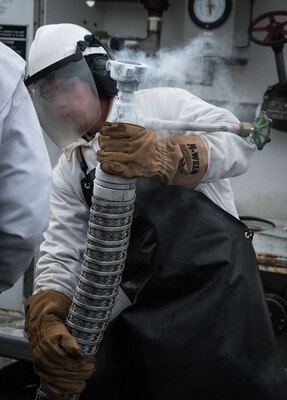By Air Force Senior Airman Curtis Beach Joint Base
Elmendorf-Richardson
JOINT BASE ELMENDORF-RICHARDSON, Alaska, Jan. 11, 2018 — As
a C-17 Globemaster III transport jet gains altitude, the air pressure
decreases, which reduces the amount of oxygen in the pilot’s blood. If
unprepared, permanent damage to vital organs can happen within minutes. To
prevent this, crew members rely on liquid oxygen.
Airmen from the 673rd Logistics Readiness Squadron fuels
facilities section here maintain this capability and other vital resources.
The fuels facilities section consists of seven airmen and
four civilians who execute and document the receipt, storage and transfer of 14
million gallons of jet fuel, ground fuel, liquid oxygen and de-icing fluid each
year.
Critical Mission
“This section is critical to the JBER mission, as they
provide the energy that moves all of our assets,” said Air Force Master Sgt.
Joshua Hightower, 673rd LRS fuels operations section chief. “Their scope of
responsibility is vast as they control all aviator breathing oxygen, vehicle
and equipment fuel, aviation fuel and de-icer products. Without the proper
management of these products, the JBER mission ceases.”
The team coordinates daily operator maintenance on assets
valued at $302 million, consisting of 10 fuel facilities and 109 fuel pits and
outlets that encompass 5 miles of pipeline throughout the base. They schedule
and coordinate daily fuel deliveries across the base for Air Mobility Command,
the Air National Guard, the Army, the transient alert section and the 3rd Wing,
as well as tenant components.
“You could say we fuel the mission,” said Air Force Tech.
Sgt. Eric Fortenberry, 673rd LRS fuels facilities section noncommissioned
officer in charge. “We handle any kind of fuel request, such as jet fuel --
that’s our main job.”
Safety Rules
Along with providing essential products, fuel facilities
airmen are focused on protecting another important asset: people. When they
work in cryogenics, the team must adhere to safety guidelines to prevent injury
or loss of life.
Handling the liquid oxygen entails risk. The team creates
liquid oxygen by placing air under high pressure. As the pressure increases,
the air temperature also increases, eventually converting the gas to a liquid
that boils off, leaving a pure gas as a result.
“The personal protective equipment we wear is absolutely
indispensable and keeps us protected,” said Air Force Senior Airman Brandon
Willen-Nelson, 673rd LRS facilities technician. “We’re handling a substance
that can reach dangerously low temperatures around minus 297 degrees
Fahrenheit. If anything spills, we’re prepared.”
Protective Equipment
Their protective equipment ensures no part of their skin is
exposed to the extremely low temperature. Operating in teams of two is an
additional safety measure, ensuring each airmen has a wingman in the event of
emergency.
Although serving as a member of the fuels facilities section
runs some risk of physical danger, Willen-Nelson said it’s all in a day’s work
and executing his part of the JBER mission is rewarding. Thanks to the 673rd
Logistics Readiness Squadron fuels facilities team, pilots and aircrew can
breathe easier as they provide global expeditionary combat support.

No comments:
Post a Comment